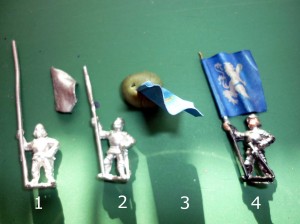The British now all painted (just waiting to be based)
…now I turn my attention to the Germans. After the usual clean up and hot glue to craft sticks they are ready to go. They are new ‘re-sculpted’ Peter Pig Germans. I haven’t seen the originals so cannot compare. When comparing to the BEF I would say that they are a little finer – the facial details are certainly finer.
The BEF had taken me longer than I really wanted, it been over 2 weeks (although I have been distracted). For the Germans my original plan was to undercoat white and gloopy wash grey and then varnish ‘stain’, in a similar way to the BEF. But instead I thought I would cut out a stage and go for a coloured primer. I would have normally used a car primer grey (which is light and neutral), but I thought I’d try an army painter primer. I originally looked at the wolf grey (to get a bluish hue), but thought it was a little too blue. The uniform grey seemed to fit the bill, and with that purchased it was down to spraying. I did go a light dusting of white over the figures in the first instance. When using the AP primers in the past I have found that you end up doing quite a heavy coat to cover all the bare metal. A tough of white primer first seems to alleviate that. It comes out a little brighter and stops a little of the capillary action pulling the paint into the recess.
After the priming I was pleasantly surprised that the grey had quite a blue hue to it anyway, so was I was looking for. It was a little dark though, and I did toy with the idea of airbrushing a highlight coat , or maybe a drybrush. BUT … I reigned myself in … this was meant to be a quick project.
So post the primer I blocked in the boots , rifle stock, pack and helmet.
Then it came to the varnish ‘dip’/’stain’. I suppose in my mind I was going to use AP dark tone. The £1 shop varnish I used last time does have a mahogany tint, and I didn’t really want to the lose the blue grey that I had achieved. The AP dark tone is based on an oily black rather than brown, so seemed to fit the bill. It also meant that the 2 protagonist armies would have a distinct tonal difference.
After that had dried , then I went back and did the face and hands. I like these to be bright, and doing this before the washes had a horrible dirtying effect. Then a bit of red piping , and a touch of metal. Then a matt varnish and the job is complete.
Overall I’m not as happy with these as the BEF. Greens and browns are much easier to pull together with this sort of wash technique. My complaints are , they are too dark for my tastes.  The AP dip is very strong. The base coat was a little too dark. If I had stuck to my original plan and gone white – acrylic wash , then I could have had more control and that stage does add a highlighting element. The overall figures just have a flat appearance with little in the way of contrast.
The AP dip is very strong. The base coat was a little too dark. If I had stuck to my original plan and gone white – acrylic wash , then I could have had more control and that stage does add a highlighting element. The overall figures just have a flat appearance with little in the way of contrast.
That said its all about getting the soldiers on the table , for this project I can let it slide.
There are more Germans than British, so I will allow myself another 2 weeks to get these done. I should probably think of this in terms of 37 days … a countdown to war…






















